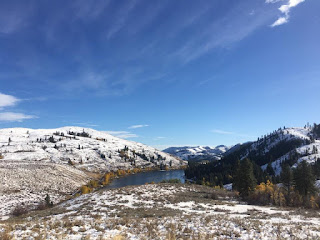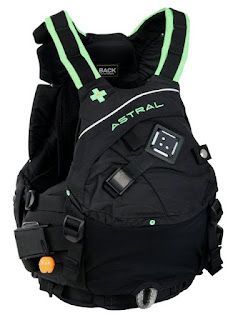Sea Kayaking Across Channels with Swift Currents
If you have ever Sea Kayaked in an area where there is a significant tidal exchange, then you know what I am talking about. Crossing a channel only couple of miles wide with swift moving water can lead to all kinds of problems.Gaining an understanding on how to safely get from one point to another point across channels is an invaluable tool.
I will set this discussion up with an example. You are on a kayak trip with friends in the wonderful San Juan Islands. You want to see as many of the islands as you can so you plan to cross from island to island to camp. Looking at your chart (a map for navigating on waterways) you see that there will time when you will be crossing channels as wide as 4 nautical miles (approx. 1 1/7 statute miles per nautical mile). Since this is your first time the region and you group has little experience kayaking in regions with moderate tidal exchanges, you simply plot a line on your chart straight across between the two desired points.

Fig 1
By simply looking at Fig 1 I hope you can see the error in judgment you are about to make. Making assumptions your group is strong enough to make-way against the current can lead to a disaster if an emergency arises. You will get swept far off course and into possibly a more dangerous situation. If you end up having to tow and kayak partner you may not have the power to paddle against the current. Thinking off all possibilities, then developing a travel route that has a bit of a buffer for error can be in your best interest.
What can you do to prevent such problems when crossing channels. First step is to take care of your route planning ahead of time at home. Use a local tide chart and create a time table of each day you plan to be on the water. Note the times of the Ebb and Flood Tides. This will help in deciding what times are best to cross a channel and what the proper heading might be for the given tide. Do not forget to account for other factors such as wind. See my previous post on wind, http://seayakwc.blogspot.com/2009/01/when-is-wind-to-strong-for-kayaking.html. You can read about how wind and current have an effect on water conditions. Make notes on your chart for possible routes in relation to different tides. Know your kayak partners capabilities. If you are not aware of what kind of pace they are capable of do some testing. Simple record the time it takes you to travel a certain distance along the shoreline. A simple calculation will give you the speed you are moving. For planning purposes and if I do not know my kayak partners that well, I use 3knots as an average speed.
You can record all of this data on your kayak using a grease pen. Everything from the days tides and times, to weather can be recorded right on your kayaks. I even use it to make notes about conditions of my kayak partners. If someone is sea sick or feeling they might get sick. It is a great tool.
A watch is needed to record time so that you can see you speed in relationship to your planned travel distance for the day. Knowing you are not going to be setup for a crossing at the time you had planned. Will allow you time to see what adjustments you need to make before arriving at that point.
Using the above example from Fig 1 I will explain two different techniques used to successfully cross a channel to your desired destination. You can choose one of two ways of getting across. The first is called ferrying. When setting up for a ferry angle you need to have a good understanding of the estimated rate of flow of the water and the paddle pace of your group. With a slow current ferrying is easier. As the current increases in flow (speed) you need to start thinking about option number 2. I like to refer to option number 2 as the distance advantage. Because you are adding more distance to your paddle but it give you an advantage on your crossing. Take a look at Fig 2 Below.

Fig 2: The Yellow Line represents the route you might have planned if you did not take current in account.
The Pink Line represents a Ferry Crossing.
The Blue Line represents a Distance Advantage Crossing.
Note the black dot on the kayaks represent the front of vessel.
Given the data in Fig 2 let’s look at the Pink Line (Ferrying). The heading you choose is not going to be the direction of travel. You want to point your kayak slightly up current. How far you choose to correct up stream will depend on your ability to make pace and not lose ground. I like to take a land mark behind off my stern and one in line off the front my bow. I can use these two points at any time to check and see if I am moving off my projected course. The objective is to side slip, so as you paddle up current you are not making forward progress. You are moving in a line sideways to you intended destination. The trick here is to be in tune with your ability to make pace against the moving water. If you cannot you will lose ground and miss your target. Plus if you it is small target and something goes wrong during the crossing. Then you can miss your target. There is less room for error when ferrying across.
Now let’s take a look at the Blue Line (Distance Advantage Crossing). You have decided the current is just too swift for your group to make a ferry crossing so now you have to make a plan. This means you simply need to follow the shoreline further up current before attempting your crossing. Make sure to give yourself enough room so that the paddle is not a struggle on your group. Maybe a little extra room if you need a quick break or an emergency. I usually start out with a nice angle to feel out the current. As I begin to make distance from my starting point I judge to see if I how far I have been moved back from the area I started. I slowly start to reduce my angle and let the current push me toward my destination. When I am within reach I flatten the angle and let the current push me against the shore of my target location. The disadvantage here is you have to add more distance to your paddle. But in the long run it may conserve energy and provide a safer approach, depending on your group.
That wraps up my topic for today. I hope for those interested in this kind of information find it helpful. It takes time and experience being on the water to develop a confident feel when crossing currents. Over compensate and experiment a bit as you develop you feel.
ANYWAY;) I want say thanks to everyone who tune into my blog and check out whats going on.
Hope everyone is having a great day.



Comments
Richard